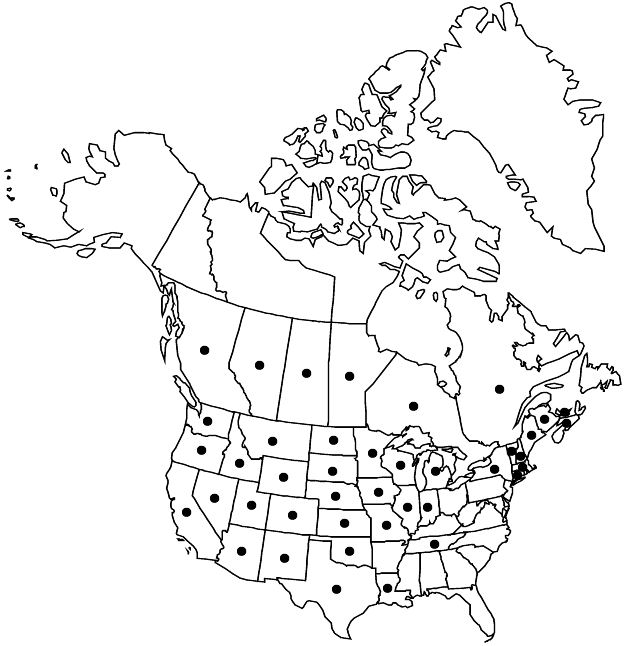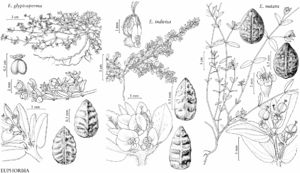Euphorbia glyptosperma
in W. H. Emory, Rep. U.S. Mex. Bound. 2(1): 187. 1859.
Herbs, annual, with taproot. Stems prostrate, loosely mat-forming, 5–40 cm, glabrous, sometimes slightly glaucous. Leaves opposite; stipules usually distinct, linear-subulate, usually irregularly fringed or lobed, rarely laciniate, 0.4–2 mm, glabrous; petiole 0.2–2 mm, glabrous; blade narrowly oblong to oblong-obovate or oblong-ovate, 3–15 × 2–7 mm, base asymmetric, one side angled and other rounded to shallowly cordate, margins minutely sparsely serrulate, especially near apex and on longer side, apex rounded to obtuse, abaxial surface usually pale grayish green, adaxial surface sometimes reddish tinged or with reddish blotch, both surfaces glabrous; palmately veined at base, pinnate distally. Cyathia solitary or in small, cymose clusters at distal nodes; peduncle 0.5–1.6 mm. Involucre obconic, 0.6–0.9 × 0.3–0.6 mm, glabrous; glands 4, red to purple, narrowly oblong-elliptic, 0.1–0.2 × 0.1–0.5 mm; appendages white or pinkish tinged, semilunate and fringing distal margin of gland, 0.1–0.3 × 0.1–0.3 mm, distal margin usually irregularly crenulate or lobed. Staminate flowers 1–5. Pistillate flowers: ovary glabrous; styles 0.1–0.3 mm, 2-fid 1/2 length. Capsules broadly ovoid, 1.3–1.9 × 1.6–2 mm, glabrous; columella 1.3–1.5 mm. Seeds with thin white coat that readily falls off, surface below tan brown, oblong-ovoid, sharply angular in cross section, 1–1.4 × 0.6–0.9 mm, with 3–4(–6) prominent transverse ridges that usually interrupt abaxial keel. 2n = 22.
Phenology: Flowering and fruiting early summer–fall.
Habitat: Stream and river banks, sand prairies, loess hill prairies, meadows, ballast, open disturbed areas, roadsides.
Elevation: 0–1800 m.
Distribution

Alta., B.C., Man., N.B., N.S., Ont., P.E.I., Que., Sask., Ariz., Calif., Colo., Conn., Idaho, Ill., Ind., Iowa, Kans., La., Maine, Mass., Mich., Minn., Mo., Mont., Nebr., Nev., N.H., N.Mex., N.Y., N.Dak., Okla., Oreg., S.Dak., Tenn., Tex., Utah, Vt., Wash., Wis., Wyo., Mexico (Chihuahua, Coahuila, Tamaulipas, Zacatecas).
Discussion
Euphorbia glyptosperma is one of the most widespread species of the genus in North America, and it is often quite weedy. It is likely native to much of the central United States, but in areas like eastern Canada, it occurs in highly disturbed habitats, and it may be adventive there. Euphorbia glyptosperma is characterized by its prominently ridged seeds, laciniate stipules, complete lack of pubescence, and somewhat obscure toothing near the tips of the leaves.
Selected References
None.
